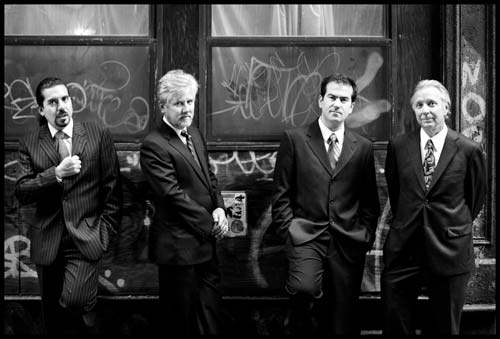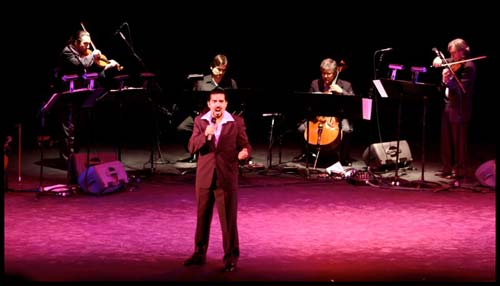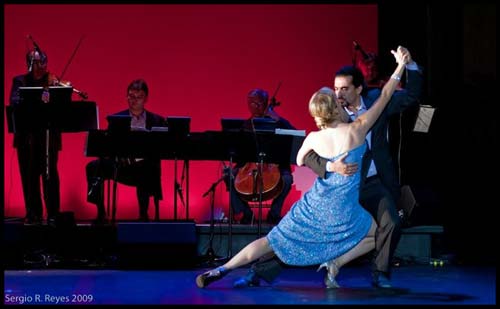By
Leonardo Suárez Paz, an interview about his career

nterview to Leonardo Suárez Paz published for Latina (Japan), August 8th, 2012
How did you begin to study to play the violin? Was violin your first instrument?
My professional life in music did not begin playing the violin. In my childhood, when I was just 6 years old, Pablo Ziegler, the pianist of Piazzolla’s last quintet and a jingle composer, became enamored by my sister Cecilia’s (Ce Suárez Paz) and mine excellent pitch and our fast ability to learn melodies and sing them; that’s how I began my career, singing for publicity and doing children’s songs. I think this was one of the jobs with which I made the most money…
I began to study the violin at the age of 8, after constant battles with my father, beginning at the age of 5, so that he would give me an opportunity to study. On my 8th birthday, my father appeared with a small violin and my teacher, who was Miguel Ángel Bertero.

Out of the things that you learned from your father, what left the biggest impression on you?
Honesty, in the whole sense of that word.
Aside from your parents, who were the people that had the biggest influence in your life, musically?
Being born into a musical family gave me the privilege to know and to be influenced by many greats of the genre whom I called uncles, such as Astor Piazzolla, Osvaldo Berlingieri, Enrique Francini, Saúl Cosentino, Osvaldo Requena, my grandfather Roberto Picolo, my mother Beatriz Suárez Paz and my father Fernando Suárez Paz. These influences of which I speak were impossible to avoid, since they are part of who I am. Aside from them I can mention, in classical music —Prokofiev, Beethoven and Bach—, to name 3 completely different eras. The influences however, are not a potion nor a percentage of what one is, the influences are what one likes, what one hears since childhood, what gives us our first important musical feelings and I can’t speak too much of that because my mother took me to listen to the Opera and to concerts when I was still in her womb.
When did you make your professional debut as a musician? How was that debut?
I made my debut at the age of 14 as a violin soloist with Teresa Parodi, playing folkloric music of the Mesopotamia and adding to the chorus, which infuriated Néstor Marconi (my music teacher), who came to my house while my father was on tour with Astor and told my mother that I was too young and that I was on a good musical path. My work with Teresa finished with my father’s return from the tour. Almost immediately after that I began to play with the Orquesta Típica of Roberto Gallardo, together with Osvaldo Requena, my father and my mother, who was singing with that orchestra. I felt like I was among family and I also began to play with the Orquesta Estable del Teatro Colón, becoming its youngest member.
Before you went to the US, with who did you play, principally?
I played as a soloist with Atilio Stampone sextet, Osvaldo Berlingieri sextet, Horacio Salgán, I played and danced for Mariano Mores and in Miguel Ángel Zotto’s Tango X 2, worked with my father and Néstor Marconi in an orchestra for a television program which was called El Gran Debut and I did a lot of other work not only as a violin soloist but also as a tango dancer.

What was your motive and reason for moving to New York?
I moved to New York when I already had made the decision to live in Buenos Aires, which is almost ridiculous but that’s what happened. I traveled a lot for my work and I wanted to live in one place, which would give me the opportunity to create and to live by doing my art, without having to travel so much. My decision culminated with an incident in which I had a revolver put to my head and robbed while I was auditioning for different classical orchestras in Buenos Aires. I was not only robbed of my material possessions but also of the desire to live next to my family and to continue the tradition of 4 generations in Tango. The day after that incident I was called to play as a violin soloist on Broadway in Forever Tango. After that everything was a success but always with a great amount of effort; work is rewarded in the United States of America and the music and friendship with great artists who helped me to stay here, such as Wynton Marsalis, Cody Moffet, Stanley Jordan and other grates of Jazz, who told me with their actions and without words to stay.
In reference to Jazz, did you already play before going to the US? Why did you also choose to play Jazz?
Jazz was always one of my passions; to play every night in Harlem in my first few years in the US was like being in San Telmo, I felt that I was in a very similar environment. I studied improvisation in Argentina, but what I studied in my native land was a preamble to a book, the ending of which I don’t know and believe that I will never know; that is what I like about this music. I was never attracted by genres that grow dusty with time, like an old record, I like for the genres to progress, I like to see them growing from their roots and extending higher and higher, with branches fighting against the sky.
Tell me about the «good» and the «bad» aspects of being an Argentine violinist in New York.
New York is one of the most cosmopolitan cities in the world, if not the most. Of course there are clicks, which you cannot enter if you do not belong there but this happens everywhere in the world. For me the most important thing is to be able to create, that my compositions are played, that my choreographies are danced and that my verses are sung.
What motivated you to create Cuartetango?
The motive was my love of this type of musical ensemble, there doesn’t exist a more perfect ensemble then a string quartet, which allows you to breath together, to vibrate and to move the bow with the same velocity and intensity, to have one unified concept. Cuartetango already has it’s history but only recently I can say that the quartet has reached its musical prime and the desired combination of classical perfection, tanguistic phrasing and rhythmical quality, which is what makes it so distinguished among the others.
I believe that the members of the quartet are two Argentines and two Americans. Is that an inconvenience?
We are two Argentines and two Americans, but it could have been two Japanese as well, because the Tango has Argentine roots but it has become international and now the curiosity and the intensity which one puts into the studying of the styles and how to play them does not require any national emblem and this is evident; being Argentine does not give me the veracity of being good, neither do my 4 generations in Tango. I am good at it because I study every day and I have talent and all of the musicians of Cuartetango are talented and very big tangueros.

What is the concept behind your second cd Masters of Bandoneon?
The bandoneon is a breathing instrument, like our string quartet. This album is dedicated to the greatest bandoneon players of the genre and to their roots. The concept is to follow the path that was laid out for us by Astor Piazzolla, not imitating him or simply playing his original arrangements but recreating and writing the future of the genre.
Perhaps people always compare you and your father. Does that bother you?
It’s normal that ignorant people base their comments on comparisons. We are two artists that when we play together, respect reigns and there isn’t another musician in the world with whom I had a better time playing then my father. The music is made in happiness, we play and we understand each other more, we love each other. I believe that I have a lot of my mother in my sound also, a sound which is more aggressive, my father is imbued in peace, like his last name – Paz.
How many times did you come to Japan?
Japan is another country which I love and which I have not visited in many years. My first time was 1989 with Mariano Mores, who was my supporter not only as a violinist, to the degree that he took the responsibility for me as a minor so that I could travel outside the country, but also a person who spoke very well of my dancing. Moreover, in the tour of ’89 in Japan he had me dancing with the singer of the group. I also went to Japan with TangoX2, playing and dancing, for the third time with Jose Colángelo and for the fourth time, in 1997, with Yoshinori Yoneyama, an example of the Japanese-porteño bohemian, a creator who I hope will never be forgotten.
How are you able to appreciate the style of your father right now?
I have and will continue to value him and his is a style that is one of my favorites. My father is a great artist and my mother is 100% tango; with her sharp character she makes tango full of accents but if one listens to the phrasing in tangos camperos, sung by my mother, it is something which any instrumentalist can learn to play tango, not only the singers.
Since 2009, Leonardo is accompanied by his wife, Olga Suárez Paz, an emerging talent of tango. Olga & Leonardo have appeared together in many venues in South and North America as guest tango dancers and with their own company, Cuartetango Music & Dance. Together Leonardo & Olga direct Cuartetango String Quartet, Cuartetango Music & Dance Company and the shows Romance de Tango and Masters of Nuevo Tango.